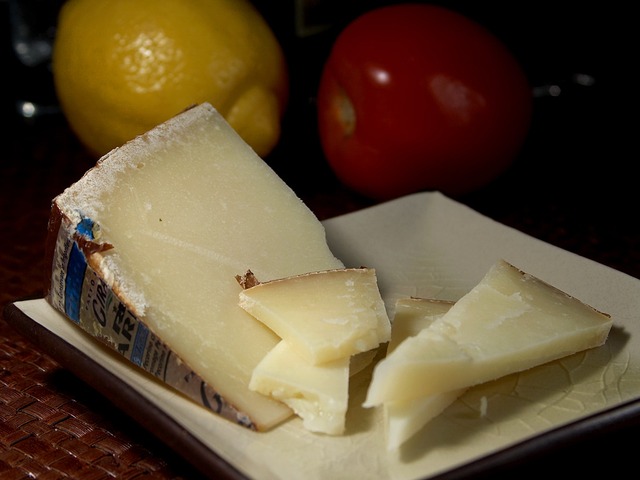Pecorino, one of the most known and loved cheese in Italy. Famous for its strong salty flavour and smell, it’s the main character of many dishes.
Origins
The Italian cheese called Pecorino, has really an ancient origin! It goes back to 2000 years ago when the sheeps grazed on the Sardinia and Lazio lands. The Romans already appreciated this kind of cheese, it was loved in the Imperial Palaces where it was considered to be the right food for banquets and it was popular because its ability to preserve for a long time. It soon became one of the main food during the travels of the Roman army. Because of the daily use of Pecorino, the soldiers were given a daily amount they could consume when they were on mission, 27 grams. But even if, after this events, it took the name of ‘Pecorino Romano‘, since 227 a.C. it was mainly produced in Sardinia. That area could provide the same environment and breeding for sheeps; the cheese became famous during 1900 when Roman and Neapolitan entrepreneurs started the mass production.
Visualizza questo post su Instagram
Varieties
Pecorino has many varieties based on the region in which it is produced, the maturing and the salting. The names of the varieties also come from the area they are produced and because of this there are pecorino romano, pecorino toscano, pecorino sardo, pecorino filiano, pecorino crotonese, pecorino picinisco, pecorino siciliano, pecorino delle Balze Volterrane. But among all of these types, the most famous are the first three, the Pecorino romano, Pecorino Toscano and Pecorino sardo. The first one even if it reminds us of Rome, it is also produced in Tuscany and even in Sardinia, it differs from the other types because of it maturing that goes from 150 to 180 days. Even the Pecorino Toscano can be produced in other regions. This kind of Pecorino has the most delicate flavour. The Pecorino Sardo type is produced on the island following a strict procedure. It differs from the others in one phase of production: it’s pressed to filtrate the whey.
Visualizza questo post su Instagram
To recap:
Pecorino Romano: from ancient times, this type of Pecorino is one of the three best known. It is recognisable by the strict procedure in the making and the aspect: its moulds are very big and can weigh from 20 to 35 kg and the height goes from 25 to 40 cm, the crust is thin and it has an ivory colour on the outside; on the inside it is really compact and the colour is white. The maturing is usually 5 months and the flavour it’s a little bit spicy.
Pecorino Toscano: it can be tasted in two varieties, the fresh one which needs a minimum of 20 days of maturing to a maximum of 60, on the outside the crust is soft and has a yellowish colour while the inside is white and tender and it has a delicate smell. The other type is the mature one which needs a minimum of 4 months of maturing, the crust is hard, thick and yellow, in the inside it’s quite hard and yellowish, the smell is a little bit more strong.
Pecorino Sardo: this kind of pecorino has two varieties, the sweet one and the mature one and the difference is the maturing time. in the first case, the maturing lasts from 20 to 60 days, in the second case, more than 60 days. As the Roman one, it is ivory on the outside and white inside, and the thickness of the inside depends on the maturing.
Pecorino Siciliano: this kind of pecorino is harder and greasy because of its olive oil covering. The outside crust has wrinkles for the different type of mould used to let it mature, inside it is hard and compact and the colour is white, the smell reminds of fruits and has a floral aroma, its taste is decisive and the spiciness of it derives from the maturation time.
Visualizza questo post su Instagram
Pecorino of Picinisco: it has two varieties, one called scamosciato, its maturing goes from 30 to 60 days and this gives it a sweeter flavour; the other one is called stagionato, its maturing goes on for more than 90 days, its flavour is stronger and spicy. Both of them have a thin and hard and very greasy crust with a brownish colour depending on the maturing time.
Pecorino of Filiano: the name has its origin in one of the major industries, the ‘filatura’ of wool (spinning) of Potenza, the place in which it was born. This kind of pecorino has to mature for a minimum of 180 days inside tuff caves. The crust is yellowish or brownish while the inside, as the flavour, is delicate and sweet when matured for short times, while if matured for longer, it can be very spicy and strong.
Pecorino Crotonese: 3 varieties, fresh, semi-hard, matured. The first one has a thin crust and the inside is compact, almost creamy with a white colour and a flavour that is soft and delicate. The semi-hard one has a brownish and hard crust, the flavour is intense and harmonic. The matured one has a really hard crust and has a strong flavour, a little bit spicy.
Pecorino delle Balze Volterrane: it’s the only cheese in Italy, made of vegetable rennet, extracted manually with a long and antique procedure; this process gives the cheese a delicate flavour with a strong smell. The crust is strong and it’s covered with ash and local spices, that were used to protect it from mold and has a greyish colour, inside the it’s white and soft.
You can enjoy this particular cheese with different types of marmalade, honey and wine.

